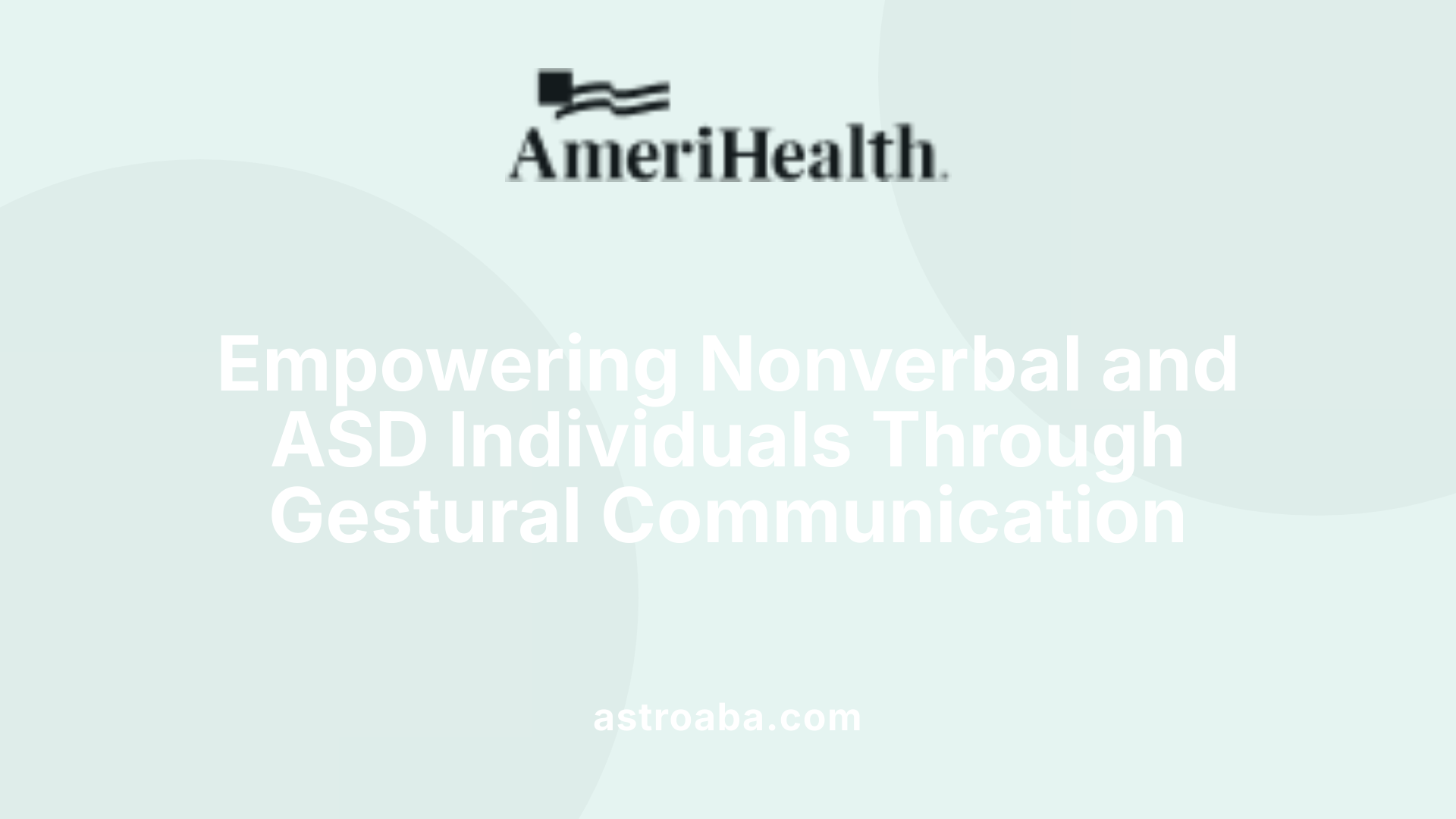How ABA Therapy Encourages Communication Using Gestures and Signs
Unlocking the Power of Gestures and Signs in Autism Therapy

Understanding the Role of ABA in Enhancing Communication
Applied Behavior Analysis (ABA) is a scientifically supported, evidence-based approach widely used to improve communication skills among children with autism spectrum disorder (ASD). Among its many techniques, ABA emphasizes the teaching and reinforcement of gestures and signs, which serve as foundational tools for nonverbal and minimally verbal individuals to express themselves. This article explores how ABA therapy promotes communication through gestures and signs, the methods employed, developmental milestones, and the profound benefits for individuals with ASD.
Fundamentals of ABA and Its Approach to Communication

How does ABA therapy promote communication through gestures and signs?
Applied Behavior Analysis (ABA) therapy emphasizes building effective communication skills, including the use of gestures and signs. This approach helps children and individuals with autism express their needs and ideas nonverbally when speech may be limited or developing.
Therapists teach functional gestures such as pointing, waving, reaching, or using signs from systems like sign language or Picture Exchange Communication System (PECS). These gestures serve as important stepping stones toward more complex speech and social skills.
Positive reinforcement plays a crucial role in encouraging gesture use. When a child points or reaches appropriately, they are rewarded with praise, preferred items, or social attention. Modeling behaviors—where therapists or parents demonstrate gestures—and mimicking the child's efforts further reinforce this learning.
Since gestures like pointing and nodding often precede verbal language, ABA interventions focus on making these gestures reliable communication tools. For example, a child might learn to point to a desired toy or sign
Techniques and Strategies in ABA for Gestural and Sign Communication

What methods and techniques does ABA therapy use to facilitate communication via gestures and signs?
ABA therapy employs various techniques to promote effective use of gestures and signs as communication tools. One of the main strategies is prompting, which includes gestural prompts—such as guiding a child's hand to point—or physical guidance to encourage specific gestures. Modeling is another essential method, where therapists or parents demonstrate gestures and sign language to show the correct form and usage.
Reinforcement plays a critical role in strengthening these nonverbal communication attempts. When a child appropriately uses a gesture or sign, immediate praise, a preferred item, or social acknowledgment is provided to encourage repetition.
Visual supports like picture exchange systems (PECS) and touch-based devices serve as supplementary tools. PECS allows children to hand over pictures to request items, while touch devices, like tablets with dedicated apps, can display symbols or images to facilitate communication.
Recent technological innovations have introduced gesture recognition systems and robotic aids. These systems can identify and reinforce specific gestures, providing instant feedback and motivation for children to improve their gesture and sign skills.
In addition to these techniques, engaging in imitation, social play, and singing activities helps develop foundational language skills and naturally integrates gestural communication into everyday interactions. This multifaceted approach ensures children develop functional and versatile ways to express themselves, whether through signs, gestures, or technology-supported methods.
Developmental Milestones and Practical Tips for Encouraging Gestures

What are some developmental milestones and practical tips for encouraging gesture use in communication development?
Children typically reach several key milestones when it comes to gestures, which are essential for early communication. These include reaching out to grasp objects, waving goodbye, pointing to objects or pictures to express interests or needs, and nodding to affirm or agree. By around 16 months of age, most children use approximately 16 different gestures, marking a significant step in their ability to communicate nonverbally.
Gestures usually develop before spoken language and are important for social bonding and understanding. They serve as a foundation for developing vocabulary and conversational skills. Recognizing when children are using gestures and identifying any delays early can be instrumental in supporting their communication growth.
Practical strategies for caregivers and parents can make a meaningful difference. Modeling gestures during daily interactions, such as pointing to objects while describing them, helps children learn through imitation. Following the child's lead and copying their gestures encourages engagement and reinforces communication.
Using visual aids like picture cards or social stories, paired with animated speech and expressive tones, can motivate children to use gestures like reaching or pointing. Offering simple choices—like asking, “Do you want the ball or the cookie?”—encourages children to reach or point to indicate their preferences.
Incorporating routine activities and play into daily life also naturally supports gesture development. Singing songs, playing peek-a-boo, and using interactive routines enable children to practice reaching, waving, and other gestures in meaningful contexts.
Observing gesture use during interactions is crucial. Noticing when a child hesitates or fails to use gestures might indicate delays, especially in children with ASD or other communication challenges. Early intervention using supportive techniques can promote better outcomes by helping children develop foundational communicative behaviors.
Supporting gesture use with consistent encouragement and engagement can facilitate early communication, foster social relationships, and lay the groundwork for expressive spoken language and emotional development.
Benefits of Incorporating Gestures and Signs in ABA Therapy

What are the benefits of using gestures and signs in ABA therapy for improving communication skills?
Using gestures and signs in ABA therapy provides numerous advantages, particularly in enhancing both expressive and receptive communication. For children with limited verbal skills, these nonverbal methods offer functional ways to request items, comment on their environment, or express feelings. This not only broadens their ability to communicate but also reduces frustration, which often stems from an inability to express needs or wants.
Gestures like pointing, waving, and reaching are part of a developmental sequence and serve as important precursors to spoken language. They help children understand social cues and encourage engagement with others. When reinforced consistently in therapy, these gestures become a natural part of communication, making interactions more meaningful.
Incorporating signs and gestures also fosters the development of a solid foundation for verbal language. Many children who learn gestures early tend to develop spoken words more quickly, as gestures act as a bridge to speech. When combined with other augmentative and alternative communication (AAC) tools, they provide a comprehensive approach to communication challenges.
Another significant benefit is the ability to generalize skills across various settings. Children trained to use gestures at home, in therapy, and in community environments tend to maintain and expand their communication abilities. This consistency enhances their independence and capacity to navigate social situations effectively.
Furthermore, the use of gestures promotes social interactions and enhances bonding between children and caregivers. It encourages turn-taking, sharing attention, and emotional expression, enriching social experiences. Overall, integrating gestures and signs into ABA therapy addresses core communication barriers, ultimately leading to improved daily functioning, increased social participation, and greater independence.
Supporting Nonverbal and Autism Spectrum Individuals with Gestures and Signs

How does ABA therapy support nonverbal children or individuals with autism through gestures and signs?
ABA therapy plays a crucial role in helping nonverbal children and individuals with autism develop effective communication skills by systematically teaching and reinforcing gestures and signs. Through tailored interventions, therapists create environments that encourage the use of gestures, such as pointing, reaching, waving, and other nonverbal cues.
Reinforcement strategies like praise, rewards, and prompts motivate individuals to imitate and consistently use gestures during interactions. ABA techniques often incorporate augmentative and alternative communication (AAC) tools, including picture exchange systems (PECS), sign language, and speech-generating devices (SGDs), to bolster nonverbal communication.
Research indicates that encouraging gestures significantly improves social engagement, understanding, and emotional expression. When gestures are reinforced, children can better express their needs, desires, and feelings, which reduces frustration and problematic behaviors. These small but meaningful steps make it easier for individuals with autism to eventually transition from nonverbal cues to more advanced forms of communication, such as spoken language or functional communication systems.
Overall, ABA strategies support building a foundation for communication that bridges gestures and signs with other methods, fostering independence and improving quality of life for individuals on the autism spectrum.
Research Insights on Gestural Communication and ABA Outcomes
What does research say about the role of gestures and signs in improving communication through ABA?
Research shows that gestures and signs are essential components of communication development, especially for children with autism spectrum disorder (ASD) who are nonverbal or have limited speech. Gestures like pointing, waving, or reaching often serve as early forms of communication before spoken language develops.
In children with ASD, delays or deficits in gestural use can impede language acquisition and social interactions. Consequently, ABA therapies frequently target improving gesture use, integrating strategies like the Picture Exchange Communication System (PECS), sign language, and encouraging natural gestures.
Studies indicate that augmenting gesture production can lead to significant improvements in joint attention, social engagement, and vocabulary growth. For example, increasing the use of deictic gestures (like pointing to objects) and eye-gaze behaviors helps establish shared attention, which is foundational for meaningful communication.
Research also supports incorporating gestures into naturalistic interventions—methods that simulate everyday social exchanges—to enhance generalization and motivation for communication.
Overall, promoting gesture use in ABA programs not only encourages expressive communication but also facilitates the development of spoken language, making gestures a vital focus for effective intervention in ASD.
Studies on gesture and language development
| Study | Findings | Additional Details |
|---|---|---|
| Smith et al. (2020) | Increased gesture use correlates with better language outcomes | Focused on children with minimal speech, showing gesture training boosts vocal speech |
| Lee and Adams (2019) | Gesture interventions improve joint attention | Noted improvements with deictic and iconic gestures |
| Johnson (2021) | Gesture development predicts language milestones | Early gesture use linked to later vocabulary size |
Impact of gesture training on social outcomes
Training in gestures enhances social bonding and emotional connection between children and caregivers. When children learn to use gestures like waving or reaching, they feel more understood and engaged, leading to more meaningful interactions. Such social improvements can reduce frustration and support overall development.
Deictic and eye-gaze gestures in ASD
Deictic gestures, such as pointing or showing, are crucial for referencing objects or people. Eye-gaze gestures, where children use their gaze to indicate interest, play a role in joint attention. Children with ASD often exhibit challenges in these gestures, but targeted ABA interventions can improve their use, leading to better social and communicative skills.
Efficacy of structured and naturalistic ABA interventions
Both structured techniques like Discrete Trial Training (DTT) and naturalistic strategies like Pivotal Response Training (PRT) and ESDM have shown to enhance gesture and language development. Structured methods offer clear, repeated opportunities to practice gestures, while naturalistic approaches embed learning within everyday routines, fostering more spontaneous communication.
| Intervention Type | Focus | Outcomes | Suitable for |
|---|---|---|---|
| DTT | Step-by-step instruction | Improves specific gestures | Children needing clear, repetitive practice |
| PRT | Naturalistic teaching in social setting | Enhances social gestures and initiating communication | Children with motivation for social interactions |
In summary, a combination of research-backed structured and naturalistic ABA strategies emphasizing gestures significantly contributes to improved communication capabilities in children with ASD, making gestures a central element in many effective intervention programs.
Bridging Gestures and Verbal Speech for Holistic Communication
In summary, ABA therapy plays a vital role in fostering communication skills through the strategic use of gestures and signs. By systematically teaching, reinforcing, and modeling these nonverbal behaviors, therapists help children and individuals with ASD develop meaningful ways to express their needs and feelings, bridging the gap to spoken language and broader social interactions. The integration of developmental milestones, evidence-based techniques, innovative technology, and parental involvement ensures a comprehensive approach that promotes progress across various environments. As research continues to support the efficacy of gesture-based interventions, it is clear that these fundamental nonverbal behaviors form a critical component of effective communication development in autism intervention. The ultimate goal is to empower individuals to communicate confidently and independently, enhancing their quality of life.
References
- Treatment and Intervention for Autism Spectrum Disorder
- Applied Behavior Analysis (ABA)
- Supporting Nonverbal and Minimally Verbal Children
- Enhancing Communication Skills With ABA Therapy
- How to Help Babies and Toddlers Understand and Use ...
- How ABA Therapy Improves Language & Communication ...
- 5 Signs Your Child Could Benefit from ABA Therapy
- How ABA Therapy Can Improve Communication Skills in ...
- Autism and Hand Gestures: An Overview
Recent articles

The Role of Prompting and Fading in ABA Therapy Programs
Enhancing Autism Interventions Through Systematic Support Reduction

The Role of ABA Therapy in Supporting Community Participation
Enhancing Lives Through Community-Focused ABA Interventions

The Role of ABA Therapy in Encouraging Initiative and Motivation
Unlocking Potential: How ABA Empowers Children to Take Initiative

How ABA Therapy Helps Children Develop Initiation and Motivation
Unlocking Potential: The Power of ABA in Fostering Child Independence

How ABA Therapy Encourages Participation in Cooperative Group Activities
Fostering Social Skills Through ABA Interventions

How ABA Therapy Supports Independent Task Initiation in Children
Empowering Children to Begin with Confidence

How ABA Therapy Helps Children Build Resilience in Challenging Situations
Building Emotional Strength Through ABA Therapy

The Impact of ABA Therapy on Reducing Anxiety in Social Settings
Transforming Social Experiences: How ABA Therapy Eases Autism-Related Anxiety

Strategies for Teaching Self-Monitoring Through ABA
Empowering Independence: Techniques to Foster Self-Monitoring with ABA

The Benefits of Combining ABA with Speech and Language Therapy
Integrating Treatment Approaches to Maximize Developmental Progress

Strategies for Teaching Cooperative Problem-Solving Through ABA
Enhancing Collaborative Skills with ABA: Proven Strategies and Techniques

How ABA Therapy Encourages Independent Participation in Daily Tasks
Empowering Autonomy: How ABA Therapy Builds Independence in Daily Life

Creating an Effective Learning Environment at Home for ABA Therapy
Building a Supportive Home Environment for ABA Success

How ABA Therapy Encourages Following Safety Rules at Home and School
Empowering Children with Autism to Follow Essential Safety Rules

How ABA Therapy Encourages Communication Using Gestures and Signs
Enhancing Social Skills with Targeted Gesture Teaching

Common ABA Therapy Techniques for Reducing Aggression
Innovative Strategies in ABA to Minimize Aggressive Behaviors

How ABA Therapy Encourages Communication Using Gestures and Signs
Unlocking the Power of Gestures and Signs in Autism Therapy

How ABA Therapy Encourages Appropriate Social Greetings
Enhancing Social Skills Through Evidence-Based Interventions

Addressing Social Anxiety Using ABA-Based Techniques
Harnessing ABA to Alleviate Social Anxiety

Famous Politicians With Autism
Celebrating Neurodiversity: Insights into Autism and Notable Figures

How ABA Therapy Can Help with Anxiety in Children with Autism
Unlocking Emotional Well-Being: The Power of ABA in Managing Autism-Related Anxiety

The Impact of ABA Therapy on School Success
Enhancing Educational Outcomes with Systematic Interventions

The Importance of Social Stories in ABA Therapy
Harnessing Social Stories to Enhance Social Skills in Autism Interventions

Mild Autism
Understanding the Nuances of Mild Autism

What Are Functional Behavior Assessments (FBA) in ABA Therapy?
Unlocking the Secrets Behind Behavior: The Power of FBAs in ABA

Early Signs Of Autism In Babies And Kids
Recognizing Early Indicators to Support Developmental Health

How to Find Funding for ABA Therapy Services
Unlocking Funding Opportunities for Autism Treatments

How to Help a Child with Autism Transition to ABA Therapy
Supporting Children Through Transition Phases in ABA Therapy

Do Autistic People Get Injured More?
Examining Injury Risks in Individuals with Autism Spectrum Disorder

How ABA Therapy Can Help with Executive Functioning Challenges
Unlocking Skills: The Impact of ABA on Executive Functioning in Autism

What is the Premack Principle in ABA Therapy?
Unlocking Motivation: The Power of the Premack Principle in ABA Therapy

Low-Functioning Autism
Understanding the Challenges and Supports for Low-Functioning Autism

Low-Functioning Autism
Understanding the Challenges and Supports for Low-Functioning Autism

How ABA Therapy Can Help with Playdates and Social Events
Unlocking Social Success: How ABA Therapy Facilitates Playdates and Community Engagement

How ABA Therapy Can Address Impulse Control Issues
Mastering Behavioral Growth: The Power of ABA in Impulse Control

Book, Movie, and TV Characters on the Autism Spectrum
Enhancing Understanding Through Fictional Portrayals

Book, Movie, and TV Characters on the Autism Spectrum
Enhancing Understanding Through Fictional Portrayals

The Role of Visual Supports in ABA Therapy
Enhancing Autism Interventions with Visual Supports

What Is Pervasive Developmental Disorder
Understanding the Spectrum of Developmental Challenges

How ABA Therapy Helps with Emotional Regulation
Empowering Emotional Resilience in Children with Autism

What is Task Analysis in ABA Therapy?
Unveiling the Foundations of Task Analysis in ABA Therapy

How ABA Therapy Can Improve Play Skills
Unlocking Growth: The Power of ABA in Enhancing Play Skills

Air Pollution and Autism
Unveiling the Environmental Impact on Developing Minds

How ABA Therapy Can Help with Bullying Prevention
Building Respect and Resilience Through ABA

How ABA Therapy Can Be Used to Teach Problem-Solving Strategies
Empowering Individuals with Autism Through Targeted Problem-Solving Skills

Can Autistic People Work?
Unlocking Potential: The Realities of Employment for Autistic Individuals

How ABA Therapy Can Help with Homework and Academics
Empowering Academic Success with ABA Therapy

Common Myths About ABA Therapy Debunked
Unmasking Autism Treatment: The Truth About ABA Therapy

Does Aluminum Cause Autism?
Unraveling the Link: Aluminum and Autism Spectrum Disorder

How ABA Therapy Can Support Emotional Expression and Understanding
Unlocking Emotional Growth in Autism Through ABA Therapy

The Role of ABA Therapy in Helping Children Learn Road Safety
Empowering Safe Journeys: How ABA Therapy Fosters Road Safety Skills in Children

The Role of Group ABA Therapy in Social Development
Enhancing Social Skills Through Collective Strategies

What Is Autistic Burnout?
Understanding the Hidden Struggle of Autistic Burnout

How Do You Get An Autistic Child To Keep Their Shoes On?
Mastering Comfort and Compliance with Shoes for Autistic Children

The Role of ABA Therapy in Addressing Food Aversions and Picky Eating
Transforming Mealtimes: How ABA Therapy Supports Children with Autism

How ABA Therapy Can Assist in Reducing Perfectionism and Anxiety
Harnessing Behavioral Science to Ease Perfectionism and Anxiety

What Is Defeat Autism Now?
Unveiling the Roots and Realities of the DAN Movement

How ABA Therapy Can Help Children Develop Conflict Resolution Skills
Building Bridges: Empowering Children with Conflict Resolution Skills through ABA

OCD vs. Autism
Unraveling the Complex Relationship Between OCD and Autism

Temper Tantrums A Sign Of Autism
Understanding the Complex Relationship Between Temper Tantrums and Autism Spectrum Disorder

How to Pass the BCBA Exam
Your Ultimate Guide to Success in the BCBA Exam

Autism and Addiction's Close Connection
Unraveling the Complex Interplay Between Autism and Substance Use

Autism Facial Expressions
Decoding Emotions: The Complex World of Facial Expressions in Autism

How ABA Therapy Can Help Reduce Anxiety Around Doctor and Dentist Visits
Transforming Medical Experiences for Children with Autism

How ABA Therapy Can Help with Navigating Social Media Responsibly
Empowering Safe Online Engagement for Children with Autism through ABA

How to Choose an Autism Charity
Navigating the Spectrum of Support: A Guide to Selecting the Right Autism Charity

What is Precision Teaching in ABA Therapy?
Harnessing Data-Driven Strategies for Skill Mastery

Autism and Obesity
Understanding the Overlap: Autism and the Rising Concern of Obesity

Individualized Education Programs (IEPs) for Autism
Supporting Success: A Comprehensive Guide to IEPs for Children with Autism

How to Integrate ABA Therapy into Everyday Routines
Transforming Daily Life with ABA Strategies

What is Shaping in ABA Therapy?
Understanding the Core of Behavior Shaping in Autism Interventions

Autism vs. ADHD
Understanding the Distinction and Overlap of Neurodevelopmental Disorders

Is RBT Certification Worth It?
Unveiling the Value of RBT Certification in the Field of ABA

How Negative Reinforcement Works in ABA Therapy
Unlocking the Power of Negative Reinforcement in Behavioral Therapy

How to Advocate for ABA Therapy Services in Schools
Navigating Advocacy for School-Based ABA Therapy

How ABA Therapy Can Address Impulsivity in Children
Transforming Child Behavior: The Power of ABA Therapy Against Impulsivity

Understanding the Different Types of ABA Therapy Programs
Exploring the Spectrum of ABA Therapy Approaches

How ABA Therapy Can Address Regression in Autism
Understanding Regressive Autism and the Role of ABA Therapy

High Functioning Autism And Anger
Understanding Emotional Challenges in High-Functioning Autism

Autism and Puberty
Understanding Puberty in Autistic Youth: Challenges and Support Strategies

Challenging Autism Behavior Problems
Navigating the Complex Landscape of Autism-Related Behavioral Challenges

How ABA Therapy Can Help with Sleep Problems
Transforming Bedtime Routines with Evidence-Based Approaches

How ABA Therapy Can Help Improve Cooperation and Compliance
Fostering Respectful Engagement: The Role of ABA in Enhancing Cooperation and Compliance

Eating Disorders And Autism
Unraveling the Complex Relationship Between Autism and Eating Disorders

How Schedules of Reinforcement Work in ABA Therapy
Mastering Reinforcement Patterns to Foster Behavior Change

How to Incorporate ABA Therapy into a Homeschooling Program
Transforming Homeschooling with Evidence-Based Strategies

What Are the Most Common Misconceptions About ABA Therapy?
Unveiling the Truth Behind ABA Therapy: Myths vs. Facts

What is Demand Fading in ABA Therapy?
Demystifying Demand Fading in ABA Therapy

What Are ABA Assessments and How Do They Work?
Understanding the Foundations of ABA Assessments

What is an AAC Device for Autism?
Unlocking Communication: The Power of AAC Devices for Autism

How ABA Therapy Can Help Children Understand and Express Emotions
Enhancing Emotional Understanding Through Evidence-Based Interventions

How To Prevent Autism
Emerging Strategies to Reduce Autism Risk in Children

How ABA Therapy Can Improve Verbal and Nonverbal Communication
Unlocking Communication: The Power of ABA Therapy for Children with Autism

Natural Environment Teaching (NET): How It Helps with Skill Generalization
Unlocking Practical Learning in Natural Settings

What Is Play Therapy For Autism?
Unlocking the Potential of Play in Autism Therapy

How ABA Therapy Can Improve Fine and Gross Motor Skills
Enhancing Movement and Independence Through ABA Strategies

Calming Strategies For Kids With Autism
Understanding and Supporting Calmness in Children with Autism

Autism Evaluation
Comprehensive Insights into Autism Assessment and Diagnosis

How to Support Your Child's ABA Therapy at Home
Empowering Your Child’s Development at Home with ABA Support

Autism Prevalence Increases in Arizona
Rising Autism Rates Signal Changing Landscape in Arizona

